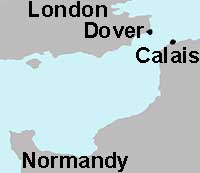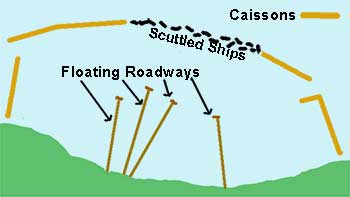D Day preparations, Operation Overlord and the Mulberry Harbour
D Day was the name given to the date of the Allies' invasion to liberate Europe from the German occupation of World War Two. In the event, the operation, known as Operation Overlord, was on June 6th 1944, but the D Day term was used from the outset of the preparations. This page is concerned with the visible signs of the preparation within Britain, despite which the date and invasion location was kept from the Germans. Crucial parts if the preparation were the deceptive strategies of Operation Bodyguard and an innovative floating harbour known as the Mulberry Harbour. These are also described and explained.
____
by Malcolm Head, a child at the time, with additional material by Neil Cryer
A great deal of planning and preparation was required for Day, particularly as it brought together the allies' land, air, and sea operations in what became the largest invasion force in human history. Some of these preparations I, and other children, were privileged to see.
The assembly and parking of equipment
The realisation of the huge amount of equipment involved for D Day and the logistics of getting it to the right place at the right time was brought home to me as a child during the Easter holidays in 1944: Some village lads and I went for a cycle ride near the wartime RAF base at St. Athan or Llandow. There we saw a truly amazing sight - in every field for miles around, aircraft and gliders were parked, many with their wings removed for easier packing together. It seemed to us that it would be impossible ever to be able to move it all.
I also saw a partially completed dual carriageway near Newport (Forge Lane), (originally intended to be part of the Newport by-pass) closed and used as a military vehicle park with every imaginable type of tank, armoured car, road tanker, field gun and ambulance stretching eight wide, nose to tail for over three miles. I understand that this scene was repeated hundreds of times across southern England.
Massive stacks of bombs were stacked alongside many of the country roads. There were no notices or warnings to stop people going near them or being mad enough to climb onto them. The stacks were quite widely separated. When I asked my father why, he said it was to make sure that if a bomb in one stack exploded it wouldn't spread to the next one along.
The movement of the equipment towards the coast
As D Day drew nearer, my friends and I saw all those parked vehicles moving in orderly waves towards the south coast ports. It was a parade to end all parades, hour after hour, day after day. Our young arms grew tired of waving to them.
The choice of site for the Normandy landings
The shortest channel crossing between England and France was Dover to Calais, as shown in the following sketch.

Relative distances from England to Calais and Normandy
However, Calais was not feasible for the landings because the German army already had a strong presence there as that was where they expected the invasion to take place.
Normandy was chosen as the alternative, because the Germans could not be expecting an invasion there. There were a number of reasons. It was some distance from Calais, involved a much wider sea crossing and had no port. To attempt to land massive numbers of troops and equipment directly onto a beach would be inviting disaster, and building a suitable harbour would take years and be impossible to hide.
Fortunately some brilliant minds came up with the solution for the problem of no harbour - see the next section.
The Mulberry Harbour
Mulberry was the codename for an entirely innovative harbour which could be assembled elsewhere and then towed into place and assembled within a few days. The harbour wall was essential to protect the Allies' ships and activities from any rough seas. Its wall was made up from skuttled ships and a number of massive hollow boxes called 'caissons', more of which in the next section.

Floating roadways for vehicles in the Mulberry Harbour
Within the harbour were floating roadways with pier heads. The incoming ships would be tied up to these to disgourge their cargo of troops and equipment which would then to speed along the floating roadways ready for battle on the German-occupied land.
The roadways were made of a series of steel bridges joining interconnecting pontoons. They could move up and down with the supply ships as they moved with the tide.
Two such Mulberry harbours were designed and at the required moment assembled in position. They were referred to as Mulberry A and B with A for the American army and B for the British. It was a brilliant design, functioned perfectly and its possibility completely fooled the Germans.
The massive seaborn activity, known as the Normandy landings, started on the 6th June 1944. The harbour assembly started on 7th June and was ready just 6 days later.
The Mulberry caissons
Caissons were essentially huge hollow, steel reinforced concrete boxes, about 60 meters long by 15 meters wide and 18 meters deep, which, being hollow, could float. In order to keep their construction secret while also spreading the workload, they were constructed at different locations scattered around the English coastline. Because they floated, they could be towed into position and sunk onto the sea bottom as required.
There were 146 Caissons used together with 70 old disused merchant ships as shown in the sketch above.
Operation Overlord: the Battle of Normandy
Operation Overlord was the codename for the Battle of Normandy. It involved the Normandy landings of more than 5000 vessels, made possible by the Mulberry harbour, and a 1,200-plane airborne assault. More than two million Allied troops were in France by the end of August, along with their battle equipment.
Operation Bodyguard
With such massive movement of troops and equipment as D Day approached, it was impossible that the Germans did not know that an invasion was imminent - but they did not know where, when or what to expect. Operation Bodyguard was a collection of strategies of deception to lead the Germans to believe that the invasion would take place later than it would, at Calais and in Norway, and with massive invading troops and equipment.
Snippets of invalid information were carefully fed back to Germany via known German spies and Allies' operators in Europe - but the most dramatic and best-known deception was with an entirely fictitious but utterly plausible large invasion force to trick the Germans into being forced to divide their defensive forces under Operations Fortitude and Quicksilver.
Operations Fortitude and Quicksilver
Operation Fortitude was the name given to the fictitious allies' army supposedly ready to invade at various places, including Norway.
Operation Quicksilver, a subset of Fortitude, was focussed on producing the plans for an invasion at Calais from Dover. This needed careful planning if it was to fool the Germans. The army was to appear massive, even though there was never any intention for it to exist. One feature involved a significant radio communications system mimicking what happens with real army units and which appeared to show considerable troop movements towards the Dover area. Also fictitious plans were leaked apparently showing plans to bomb the Calais area, particularly the railways. This was to mimic what would happen if Calais was to be the true landing site. Quicksilver also included the setting up of additional wireless stations around Dover as well as an assembly of dummy landing craft and extra lighting in areas around Dover to show intense activity. Newsreels and films often show the inflated tanks, which looked just like real ones from the air, but could, in fact, be kicked over.
The bluff was based on an American plan set up for a different purpose two years previously. It was remarkably successful in misleading the Germans on the true date and size of the Allies' invasion force.
The arrival of D Day
On D Day itself, the air was thick with thousands of aircraft. The roar of their engines was incessant; it was almost impossible for us lads to believe that there were that many aeroplanes in the world. There was never a sight like it before, nor will there be ever again.
Excitement at the success of D Day
Never before or since can I remember such excitement in the papers and on the wireless.
At school, a large map of Europe was pinned on the wall, and we children would follow the Allied progress through France and Germany, shading 'our' part and marking liberated cities with little flags.
| sources | webmaster | contact |
Text and images are copyright
If you can add anything to this page or provide a photo, please contact me.



